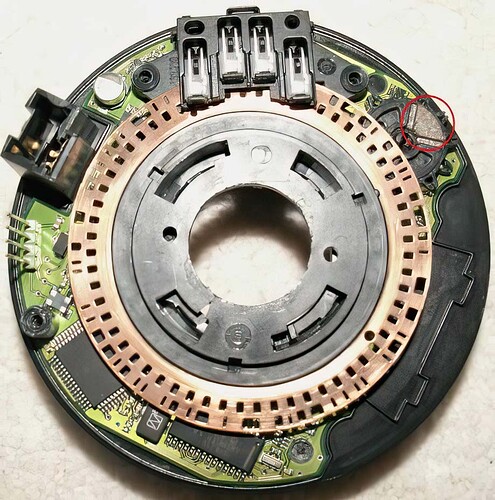here is a full rotation in binary and in decimals:
0000,
1000,
1010,
1110,
1111,
1011,
1001,
1000,
1100,
1110,
0110,
0111,
0011,
0001,
0101,
0100,
0110,
1110,
1111,
1101,
1100,
0100,
0000,
0010,
0011,
0001,
1001,
1000,
1100,
1110,
1111,
0111,
0101,
1101,
1001,
1000,
0000,
0010,
0011,
0111,
0101,
1101,
1100,
0100,
0110,
1110,
1010,
1011,
1111,
1101,
1001,
1000,
1010,
1011,
1111,
1101,
0101,
0001,
0000,
1000,
1100,
1110,
0110,
0111,
1111,
1101,
1100,
0100,
0110,
1110,
1111,
1011,
1001,
0001,
0101,
0100,
1100,
1000,
1010,
1110,
1111,
0111,
0101,
0001,
0000,
0100,
0110,
1110,
1111,
0111,
0011,
0001,
0101,
0100,
1100,
1110,
0110,
0010,
0011,
1011,
1001,
0001,
0000,
0100,
0110,
1110,
1010,
1011,
1001,
1101,
1100,
0100,
0000,
0010,
0110,
0111,
0011,
0001,
0000,
1000,
1100,
1110,
1111,
1101,
0101,
0001,
0000,
1000,
1010,
1011,
1001,
0001,
0101,
0100,
0110,
0111,
0011,
1011,
1001,
0001,
0101,
0100,
1100,
1110,
1111,
1011,
0011,
0001,
0000,
1000,
1010,
1110,
0110,
0111,
0011,
1011,
1001,
1101,
1100,
1110,
1010,
1011,
0011,
0001,
0101,
1101,
1100,
1000,
0000,
0010,
0110,
1110,
1111,
1101,
0101,
0100,
0110,
0010,
1010,
1011,
1111,
0111,
0101,
0001,
1001,
1000,
0000,
0100,
0110,
0111,
0011,
0001,
1001,
1000,
0000,
0100,
0110,
0010,
0011,
0111,
0101,
0001,
1001,
1000,
1010,
0010,
0011,
0111,
1111,
1101,
1001,
1000,
0000,
0010,
1010,
1011,
1111,
1101,
1100,
1000,
1010,
1110,
1111,
1101,
1001,
1000,
0000,
0100,
0110,
1110,
1111,
0111,
0101,
1101,
1100,
1110,
0110,
0111,
0101,
0001,
1001,
1000,
1100,
1110,
1010,
1011,
1111,
1101,
0101,
0100,
0000,
0010,
0011,
1011,
1111,
1101,
1100,
1110,
1111,
1011,
1001,
0001,
0000,
0010,
1010,
1110,
1111,
0111,
0101,
0100,
1100,
1110,
0110,
0111,
0011,
1011,
1001,
1000,
0000,
0100,
0110,
0010,
1010,
1011,
0011,
0001,
0101,
0100,
1100,
1000,
1010,
0010,
0110,
0111,
1111,
1101,
1001,
1000,
1100,
1110,
0110,
0010,
0011,
0001,
0101,
0100,
0000,
0010,
0110,
0111,
1111,
1101,
0101,
0100,
1100,
1000,
1010,
1011,
0011,
0001,
1001,
1000,
1010,
1110,
1111,
1011,
0011,
0001,
1001,
1101,
1100,
1110,
1010,
0010,
0011,
0111,
1111,
1101,
0101,
0100,
1100,
1110,
1010,
1011,
0011,
0111,
0101,
0100,
0000,
0010,
1010,
1110,
1111,
1011,
1001,
1101,
1100,
0100,
0110,
0010,
0011,
0001,
0000,
0100,
0110,
0111,
1111,
1101,
1001,
0001,
0000,
0010,
1010,
1011,
0011,
0001,
0000,
0010,
0110,
0111,
0011,
1011,
1001,
0001,
0000,
1000,
1100,
1110,
1010,
1011,
1001,
1000,
1010,
0010,
0110,
0111,
0011,
0001,
0101,
1101,
1100,
0100,
0110,
0111,
0101,
0100,
0000,
1000,
1010,
0010,
0011,
0111,
0101,
0001,
0000,
1000,
1010,
0010,
0011,
1011,
1001,
1101,
1100,
1000,
1010,
0010,
0011,
0001,
1001,
1101,
1100,
1000,
1010,
0010,
0110,
0111,
0101,
1101,
1100,
0100,
0000,
0010,
1010,
1011,
0011,
0111,
0101,
1101,
1100,
1000,
1010,
1011,
0011,
0111,
0101,
0001,
0000,
1000,
1100,
1110,
0110,
0010,
0011,
0111,
0101,
0100,
0110,
0010,
0011,
1011,
1001,
0001,
0101,
0100,
0000,
0010,
1010,
1011,
1001,
0001,
0
8
10
14
15
11
9
8
12
14
6
7
3
1
5
4
6
14
15
13
12
4
0
2
3
1
9
8
12
14
15
7
5
13
9
8
0
2
3
7
5
13
12
4
6
14
10
11
15
13
9
8
10
11
15
13
5
1
0
8
12
14
6
7
15
13
12
4
6
14
15
11
9
1
5
4
12
8
10
14
15
7
5
1
0
4
6
14
15
7
3
1
5
4
12
14
6
2
3
11
9
1
0
4
6
14
10
11
9
13
12
4
0
2
6
7
3
1
0
8
12
14
15
13
5
1
0
8
10
11
9
1
5
4
6
7
3
11
9
1
5
4
12
14
15
11
3
1
0
8
10
14
6
7
3
11
9
13
12
14
10
11
3
1
5
13
12
8
0
2
6
14
15
13
5
4
6
2
10
11
15
7
5
1
9
8
0
4
6
7
3
1
9
8
0
4
6
2
3
7
5
1
9
8
10
2
3
7
15
13
9
8
0
2
10
11
15
13
12
8
10
14
15
13
9
8
0
4
6
14
15
7
5
13
12
14
6
7
5
1
9
8
12
14
10
11
15
13
5
4
0
2
3
11
15
13
12
14
15
11
9
1
0
2
10
14
15
7
5
4
12
14
6
7
3
11
9
8
0
4
6
2
10
11
3
1
5
4
12
8
10
2
6
7
15
13
9
8
12
14
6
2
3
1
5
4
0
2
6
7
15
13
5
4
12
8
10
11
3
1
9
8
10
14
15
11
3
1
9
13
12
14
10
2
3
7
15
13
5
4
12
14
10
11
3
7
5
4
0
2
10
14
15
11
9
13
12
4
6
2
3
1
0
4
6
7
15
13
9
1
0
2
10
11
3
1
0
2
6
7
3
11
9
1
0
8
12
14
10
11
9
8
10
2
6
7
3
1
5
13
12
4
6
7
5
4
0
8
10
2
3
7
5
1
0
8
10
2
3
11
9
13
12
8
10
2
3
1
9
13
12
8
10
2
6
7
5
13
12
4
0
2
10
11
3
7
5
13
12
8
10
11
3
7
5
1
0
8
12
14
6
2
3
7
5
4
6
2
3
11
9
1
5
4
0
2
10
11
9
1
